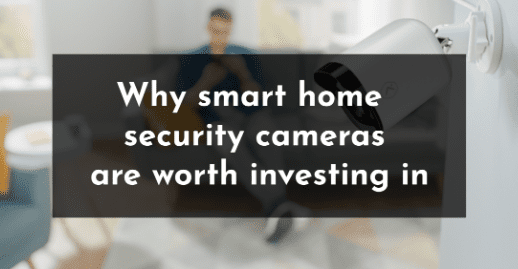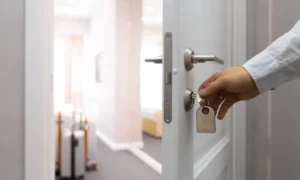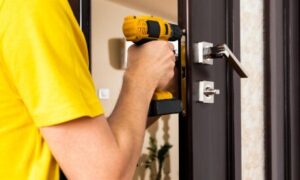If you’re like most people, you probably think of home security cameras as a way to keep an eye on your property when you’re not there. While this is certainly one of the things that they can do, home security cameras can also, do a lot more to keep you and your family safe.
What are smart home security cameras and what can they do for you
Smart home security cameras are a great way to keep an eye on your property while you’re away. Not only can they help you catch criminals in the act, but they can also provide you with peace of mind by sending notifications to your phone if something unexpected happens. Security cameras with night vision can keep your house safe even in complete darkness.
Some of the other things that smart home security cameras can do include:
- Monitoring your children and elderly
- You can keep your package safe at your front door when you order online and have it delivered
- Helping you keep an eye on your pets while you’re away
- Connecting to your smart home system like Google assistant or Apple Siri.
The smart features on a security camera that will blow your mind
A security camera is a great addition to any smart home. By installing a security camera, you can rest assured that your home and belongings are always being monitored. In addition, many security cameras come with features that allow them to work with other devices in your home. For example, some security cameras can send notifications to your phone when they detect movement or sound. This allows you to be alerted immediately if something unexpected happens at home.
The features of a security camera that will blow your mind are the options it has to connect with other devices in your home. With this feature, you can be sure that you’re getting notifications about what’s happening at home whether you’re there or not. Additionally, these cameras come with many other features that allow you to keep an eye on your property and loved ones while you’re away. So, if you’re looking for a way to increase the security of your home, a security camera is worth investing in.
How to choose the right security camera for your needs
There are a variety of different types of security cameras on the market, and each has its own set of pros and cons. Here are some of the most common types of security cameras and what you need to know about them:
Indoor Cameras
Indoor security cameras are typically small, discreet, and easy to install. They’re perfect for use in homes and businesses and can be used to monitor everything from entryways to cash registers. One downside to indoor security cameras is that they may not be able to withstand the elements, so they should not be used outdoors.
Outdoor Cameras
Outdoor security cameras are designed to withstand the elements, making them perfect for use in both homes and businesses. They can be used to monitor entrances, exits, parking lots, and other areas outside of your home or business. One downside to outdoor security cameras is that they may be more difficult to install than indoor cameras.
Wireless Cameras
Wireless security cameras are perfect for use in homes and businesses with limited or no wiring. They can be installed almost anywhere and can transmit footage wirelessly to a receiver or recording device. One downside to wireless security cameras is that they may not be as reliable as wired cameras.
Wired Cameras
Wired security cameras are typically more reliable than wireless cameras, but they require a wired connection to a power source and a recording device. One upside to wired security cameras is that they typically have a longer lifespan than wireless cameras.
When choosing a security camera, it is important to consider your needs and the environment in which you will be using the camera. Here are some things to keep in mind when choosing a security camera:
1. Indoor or Outdoor?
If you will be using the camera outdoors, you will need to choose an outdoor-rated camera that can withstand the elements. If you will be using the camera indoors, you may have more options, including indoor-rated cameras that are smaller and more discreet.
2. Wired or Wireless?
Wired cameras provide a more reliable connection than wireless cameras, but they require a wired connection to a power source and a recording device. Wireless cameras can be installed almost anywhere, but they may not be as reliable as wired cameras.
If you’re looking for a security camera without wifi connection, there are a few options available. Some security cameras come with a built-in storage device that records footage locally, so you don’t need to have a wifi connection to view the footage. Additionally, some security cameras can be connected to a TV or other recording device to view the footage without a wifi connection.
3. Fixed or PTZ?
Fixed security cameras stay in one place and monitor a specific area, while PTZ (pan-tilt-zoom) security cameras can be moved to monitor different areas. PTZ security cameras offer more flexibility, but they can also be more expensive than fixed cameras.
4. Bullet or Dome?
A bullet security camera is a type of fixed security camera that is shaped like a bullet and typically has a long lens. Bullet security cameras are commonly used to monitor outdoor areas such as parking lots and entrances/exits. One advantage of bullet security cameras is that they can often capture more detail than dome security cameras.
A dome security camera is a type of fixed security camera that is shaped like a dome and typically has a shorter lens. Dome security cameras are commonly used to monitor indoor areas such as hallways and retail stores. One advantage of dome security cameras is that they are less likely to be vandalized than bullet security cameras.
The best ways to use a security camera to protect your home
There are a variety of ways that you can use a security camera to protect your home. Here are some of the best ways to use a security camera to protect your home:
- Place cameras at entrances and exits to monitor who is coming and going.
- Place cameras in key areas inside your home, such as in the living room, kitchen, or bedroom, to keep an eye on what is happening when you’re not there.
- Place cameras in outdoor areas around your home, such as the yard, driveway, or porch, to monitor activity outside of your home.
- Use motion-activated cameras to detect activity and send notifications to your phone or email.
- Use the cloud-based recording to store footage from your security cameras online so that you can access it from anywhere.
Conclusion
Smart home security cameras are worth investing in because they can help you keep an eye on your home when you’re not there. You should choose a security camera based on your real needs, however, and not just based on what is popular or what others are using. There are a variety of options to choose from, so take the time to research which camera is right for you.





































